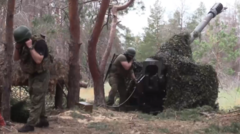Russia has ramped up its military operations in Ukraine, particularly through increased drone and missile attacks, yet it faces staunch resistance on the ground. Reports indicate that Russian forces managed to seize a substantial 556 square kilometers (215 square miles) last month, marking their largest land acquisition of the year. This area is roughly four times the size of Liverpool and nearly equivalent to the city of Chicago.
The primary goal of Russia appears to be the disruption of supply lines utilized by Ukrainian troops in the eastern territory and the establishment of a buffer zone within Ukraine's northern border. However, progress has been slow; at the current rate, total conquest of the country would take over 70 years.
Russian military operations are being concentrated in three specific areas: the Sumy region bordering Russia, the eastern cities of Pokrovsk and Kostyantynivka, and a new front west of Pokrovsk. Recent operations saw Russian troops advancing about 10-12 kilometers (6-7.5 miles) into the Sumy region, but these advances were quickly halted due to robust Ukrainian defensive strategies.
Russian President Vladimir Putin has expressed a desire to create a buffer zone following last summer's Ukrainian gains within Russian territory, but efforts have stalled as the fighting has become mired in skirmishes over small villages. Reports suggest that without major reinforcements, continuous advances are unlikely.
Additional claims of territorial capture in Kharkiv territory were marked by limited troop movements, and military analysts believe these tactics are aimed at stretching Ukrainian forces thin over a 1,200-km frontline rather than achieving rapid territorial gains.
Pokrovsk remains critical for both sides, with Ukrainian Army General Oleksandr Syrskyi noting that around 111,000 Russian troops have amassed in the vicinity. Notably, large-scale Russian assaults are rare, with the army resorting to smaller, relentless infantry attacks instead. This strategy aims to wear down Ukrainian defenses gradually, albeit at a heavy cost, with Ukrainian officials placing Russian daily casualties at over 1,000 soldiers.
In the context of the ongoing battle around Pokrovsk and Kostyantynivka, Russian forces appear inclined towards encircling Ukrainian troops, but major breakthroughs remain elusive. Currently, reports suggest that Russian advances have slowed considerably in areas near these cities.
The most alarming Russian progress of late has been reported further west of Pokrovsk in an area referred to as Novopavlivske. Russian military commentators noted rapid advances in this region, raising alarm among Ukrainian forces. However, Ukrainian officials promptly denied claims of territorial acquisition into the neighboring Dnipropetrovsk region.
Despite the increasing pressure on Ukrainian defenses and the severe disruptions to supply lines caused by persistent Russian drone attacks, Ukrainian troops remain resolute. They are adapting to the changing conditions, utilizing innovative methods for supplies amidst ongoing challenges, as enemy tactics involve not only military objectives but also strikes aimed at undermining civilian morale.



















